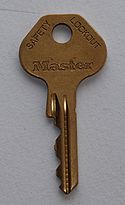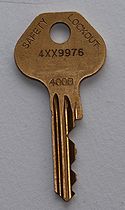Key: Difference between revisions
No edit summary |
mNo edit summary |
||
| Line 4: | Line 4: | ||
Non-electronic keys are created using aluminum, brass, iron, nickel-silver, steel, or zamak. The material used depends on the type of lock and the required durability and longevity of the key. | Non-electronic keys are created using aluminum, brass, iron, nickel-silver, steel, or zamak. The material used depends on the type of lock and the required durability and longevity of the key. | ||
__TOC__ | |||
== History == | == History == | ||
| Line 9: | Line 11: | ||
== Parts of a Key == | == Parts of a Key == | ||
[[Image:Lockwiki_Key_front.jpg|thumb|125px|Master Lock key, front.]] | |||
[[Image:Lockwiki_Key_back.jpg|thumb|125px|Master Lock key, back.]] | |||
; Bitting | ; Bitting | ||
| Line 49: | Line 54: | ||
; Cruciform | ; Cruciform | ||
: A key that uses four bittings, giving it a star shaped tip. May not actually use all | : A key that uses four bittings, giving it a star shaped tip. May not actually use all four, like a convenience key. | ||
== Compromise of Keys == | == Compromise of Keys == | ||
Revision as of 17:44, 19 January 2009
Key
A physical object that is used to open a lock. Keys are inserted into a lock to cause internal components to align, allowing the lock to open. In electronic locks, keys may transmit information electronically rather than manipulate physical components.
Non-electronic keys are created using aluminum, brass, iron, nickel-silver, steel, or zamak. The material used depends on the type of lock and the required durability and longevity of the key.
History
Add to me!
Parts of a Key
- Bitting
- The part of the key that makes contact with internal components. Cuts on the bitting allow internal components to be moved to different positions.
- Blade
- The shaft of the key which holds the wards, bitting, and cuts.
- Bow
- The handle which is used to turn the key. Commonly contains the lock manufacturer's logo, the keyway type, and key codes. Bows are generally patented, allowing keys to be quickly associated with certain manufacturers.
- Code(s)
- Characters stamped on the bow of the key that define what the cut depths for the key are or what model the keyway is.
- Cuts
- The cuts made on the bitting of the key. Cuts are used to properly align internal components of the lock, allowing the key to actuate the locking mechanism and unlock the lock.
- Keyway
- The profile of the key created by the blade and the wards. This is the inverse of the keyway of the lock.
- Shoulder
- The part of the key that connects the bow to the blade. The shoulder is commonly responsible for stopping the key from being inserted further, allowing the cuts to be properly aligned in the lock.
- Tip
- The end of the key opposite of the bow. Some locks use the tip of the key to align cuts instead of the shoulder.
- Warding
- Distortions to the blade of the key to prevent it from being used in a lock with a different keyway. Warded locks use this as their primary means of security.
Types of Keys
- Single Bitted
- The traditional key with one set of cuts on the bitting.
- Multi Bitted
- A key with several sets of cuts, thus giving them multiple bitting surfaces. Common in high security locks that have auxilliary locking mechanisms, such as a sidebar.
- Convenience
- A key with duplicate cuts but only one actual bitting surface, allowing the key to be functional when inserted in any orientation.
- Cruciform
- A key that uses four bittings, giving it a star shaped tip. May not actually use all four, like a convenience key.
Compromise of Keys
The compromise of a key or keying system may constitute a serious vulnerability in a locking system. Keys that are examined, borrowed, or stolen can be impressioned or decoded. Analysis of keys within a master system may also contribute to compromise of the overall system, depending on the specifics of the system and the key obtained.

